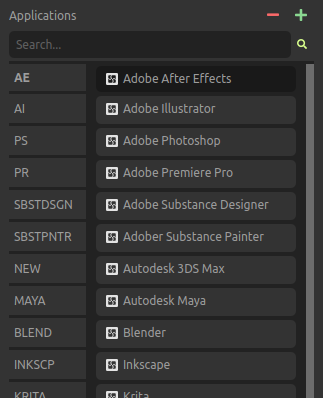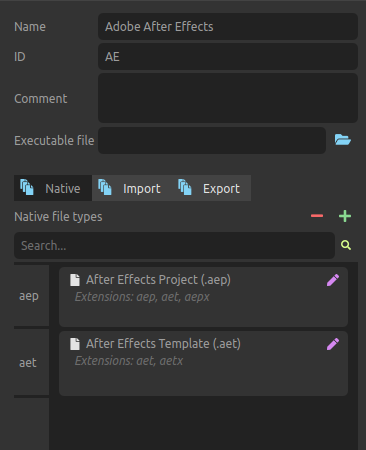 Application management
Application management

This panel is used to list and manage all the applications Ramses needs to know for the pipeline management.
Read the section about the Pipeline for more details about how applications are used.
List

The list on the left lists all the applications, and you can use the Search field to filter them by name or ID.
Use the button to create a new application. The
button removes the selected applications from Ramses1.
You can use the [Shift + A] shortcut key to quickly add new applications.
You can use the [DEL] or [Shift + X] shortcut key to quickly remove selected applications.
You can scroll all lists using [Middle click] as well as the [Mouse wheel].
Ramses comes with a predefined list of applications, but this list is completely customizable: you can remove and add as many applications as you need.
Edition

- Name is the state’s display name.
- ID is the unique identifier which is used in the files and folders (see the Ramses Tree section and the Ramses naming convetions).
- Comment can be any text associated to the application, describing it.
- Executable file is the path to the executable binary used to launch the application.
- The blue
button opens a file selector to change the file path.
- The blue
- The Native, Import and Export buttons display three lists of file types to be associated with the application:
- Native file types are the ones which can be edited (read and written while keeping them editable) with the application.
- Import file types are files which can be read by the application.
- Export file types are files which can be written by the application, but losing the ability to edit it later.
- The
button contains a list of available file types, and an entry to quickly create a new file type without having to switch to the file types tab.
- The
button unassigns the selected file types from the application but does not remove them from Ramses. You can also use the
[DEL]key. - From the list, you can use the
edit button to edit them in a side docked panel. Read the file type management section for more details about file type edition.
Tip
The executable file field is optional. To open a specific file, if this field is left empty, Ramses will use the default application from the system instead, so it may be quicker and easier to set the file association at the system level.
Using this field can be handy in case you’re using different versions of the same software, or if you want to override default file association, in which case Ramses needs the actual executable file path.
▹ More details about the pipeline.
-
The data is not actually deleted from the server nor the local data, but just flagged as removed. A server administrator can still restore the data at any time, but there is no way (yet) to do that from the user interface of the application. ↩